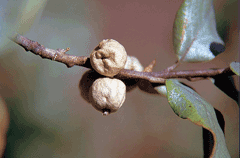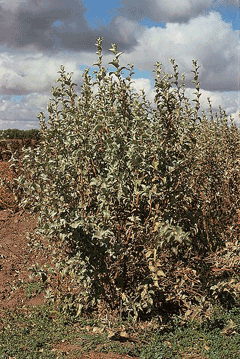 |
|
USDA-NRCS PLANTS Database |
 |
| USDA-NRCS PLANTS Database |
Translate this page:
Summary
Physical Characteristics

 Elaeagnus_commutata is a deciduous Shrub growing to 3 m (9ft) by 1.5 m (5ft) at a medium rate.
Elaeagnus_commutata is a deciduous Shrub growing to 3 m (9ft) by 1.5 m (5ft) at a medium rate.
See above for USDA hardiness. It is hardy to UK zone 2 and is not frost tender. It is in flower in May, and the seeds ripen from July to September. The species is hermaphrodite (has both male and female organs) and is pollinated by Bees.
It can fix Nitrogen.
Suitable for: light (sandy), medium (loamy) and heavy (clay) soils, prefers well-drained soil and can grow in nutritionally poor soil. Suitable pH: mildly acid, neutral and basic (mildly alkaline) soils and can grow in very alkaline soils.
It cannot grow in the shade. It prefers dry or moist soil and can tolerate drought. The plant can tolerate maritime exposure.
UK Hardiness Map
US Hardiness Map
Synonyms
E. argentea. non Moench.
Plant Habitats
Edible Uses
Fruit - raw or cooked[1, 2, 3, 43, 106]. Dry and mealy[11, 95, 172, 183]. Good when added to soups they also make an excellent jelly[183]. The fruit must be fully ripe before it can be enjoyed raw, if even slightly under-ripe it will be quite astringent[K]. The fruit contains a single large seed[K]. Seed - raw or cooked. It can be eaten with the fruit though the seed case is rather fibrous[K].
References More on Edible Uses
Medicinal Uses
Plants For A Future can not take any responsibility for any adverse effects from the use of plants. Always seek advice from a professional before using a plant medicinally.
A strong decoction of the bark, mixed with oil, has been used as a salve for children with frostbite[257]. A decoction of the roots, combined with sumac roots (Rhus spp.), has been used in the treatment of syphilis[257]. This medicine was considered to be very poisonous and, if you survived it, you were likely to become sterile[257]. The fruit of many members of this genus is a very rich source of vitamins and minerals, especially in vitamins A, C and E, flavanoids and other bio-active compounds. It is also a fairly good source of essential fatty acids, which is fairly unusual for a fruit. It is being investigated as a food that is capable of reducing the incidence of cancer and also as a means of halting or reversing the growth of cancers[214].
References More on Medicinal Uses
The Bookshop: Edible Plant Books
Our Latest books on Perennial Plants For Food Forests and Permaculture Gardens in paperback or digital formats.

Edible Tropical Plants
Food Forest Plants for Hotter Conditions: 250+ Plants For Tropical Food Forests & Permaculture Gardens.
More

Edible Temperate Plants
Plants for Your Food Forest: 500 Plants for Temperate Food Forests & Permaculture Gardens.
More

More Books
PFAF have eight books available in paperback and digital formats. Browse the shop for more information.
Shop Now
Other Uses
Plants can be grown as a hedge in exposed positions, tolerating maritime exposure. They have a rather open habit, however, and so do not afford a lot of wind protection. Because they fix atmospheric nitrogen, they enrich the soil and so make a very good companion hedge in orchards etc[K]. The fibrous bark is used in weaving, it has been twisted to make strong ropes and has also been used to make blankets and clothing[99, 257]. Dried fruits are used as beads[99, 257]. The berries have been used to make a soap[257].
Special Uses
References More on Other Uses
Cultivation details
An easily grown plant, it succeeds in most soils that are well-drained[200], though it dislikes shallow chalk soils[98]. This last report conflicts rather with the record of its natural habitat, it should grow well on chalk[K]. Prefers a light sandy soil that is only moderately fertile, succeeding in poor and dry soils[11, 200]. Requires a position in full sun[11, 200]. Plants are very drought and wind resistant[1, 11, 200]. A very hardy plant, tolerating temperatures down to about -40°c[184]. However, plants prefer a continental climate and are liable to be cut back in severe winters in Britain mainly because the wood is not fully ripened in our cooler summers. A moderately fast-growing plant[202]. The small flowers are deliciously scented[245]. This species does not normally require pruning but the plant can regenerate from very old wood and so can be cut back severely if required[202]. Plants resent root disturbance and should be placed in their permanent positions as soon as possible[202]. This species has a symbiotic relationship with certain soil bacteria, these bacteria form nodules on the roots and fix atmospheric nitrogen. Some of this nitrogen is utilized by the growing plant but some can also be used by other plants growing nearby[200]. An excellent companion plant, when grown in orchards it can increase yields from the fruit trees by up to 10%. Often confused with E. angustifolia even though it is very distinct[50]. Plants produce suckers quite freely, often sending them up at some distance from the plant[182, K]. This species is notably resistant to honey fungus[88, 200]. The plant is heat tolerant in zones 6 through 1. (Plant Hardiness Zones show how well plants withstand cold winter temperatures.
Plant Heat Zones show when plants would start suffering from the heat.
The Plant Heat Zone map is based on the number of "heat days" experienced in a given area where the temperature climbs to over 86 degrees F (30°C).
At this temperature, many plants begin to suffer physiological damage. Heat Zones range from 1 (no heat days) to 12 (210 or more heat days).
For example Heat Zone. 11-1 indicates that the plant is heat tolerant in zones 11 through 1.) For polyculture design as well as the above-ground architecture (form - tree, shrub etc. and size shown above) information on the habit and root pattern is also useful and given here if available. The plant growth habit is multistemmed with multiple stems from the crown [1-2]. The root pattern is flat with shallow roots forming a plate near the soil surface [1-2]. The root pattern is stoloniferous rooting from creeping stems above the ground [1-2].
References Carbon Farming Information and Carbon Sequestration Information
Temperature Converter
Type a value in the Celsius field to convert the value to Fahrenheit:
Fahrenheit:
The PFAF Bookshop
Plants For A Future have a number of books available in paperback and digital form. Book titles include Edible Plants, Edible Perennials, Edible Trees,Edible Shrubs, Woodland Gardening, and Temperate Food Forest Plants. Our new book is Food Forest Plants For Hotter Conditions (Tropical and Sub-Tropical).
Shop Now
Plant Propagation
Seed - best sown as soon as it is ripe in a cold frame[78]. It should germinate in late winter or early spring, though it may take 18 months[K]. Stored seed can be very slow to germinate, often taking more than 18 months. A warm stratification for 4 weeks followed by 12 weeks cold stratification can help[98]. The seed usually (eventually) germinates quite well[78]. Prick out the seedlings into individual pot as soon as they are large enough to handle and plant out when they are at least 15cm tall. Cuttings of half-ripe wood, 7 - 10cm with a heel, July/August in a frame. Cuttings of mature wood of the current year's growth, 10 - 12cm with a heel, October/November in a frame[200]. The cuttings are rather slow and difficult to root, leave them for 12 months[113]. Layering in September/October. Takes 12 months[78]. Division of suckers during the dormant season[3, 11]. The larger suckers can be planted out direct into their permanent positions, but it is probably best to pot up smaller suckers and grow them on in a cold frame until they are established.
Other Names
If available other names are mentioned here
Gin'yo-gumi,
Native Range
NORTHERN AMERICA: Canada, Northwest Territories (southwest), Yukon, Québec, Ontario (north), Saskatchewan, Alberta, Manitoba, British Columbia, United States, Alaska (south), Minnesota (west), North Dakota, South Dakota, Idaho, Montana, Wyoming (west), Utah,
Weed Potential
Right plant wrong place. We are currently updating this section.
Please note that a plant may be invasive in one area but may not in your area so it’s worth checking.
Conservation Status
IUCN Red List of Threatened Plants Status :

Growth: S = slow M = medium F = fast. Soil: L = light (sandy) M = medium H = heavy (clay). pH: A = acid N = neutral B = basic (alkaline). Shade: F = full shade S = semi-shade N = no shade. Moisture: D = dry M = Moist We = wet Wa = water.
Expert comment
Author
Bernh. ex Rydb.
Botanical References
1143200
Links / References
For a list of references used on this page please go here
Readers comment
© 2010, Plants For A Future. Plants For A Future is a charitable company limited by guarantee, registered in England and Wales. Charity No. 1057719, Company No. 3204567.